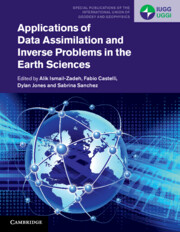Book contents
- Applications of Data Assimilation and Inverse Problems in the Earth Sciences
- Series page
- Applications of Data Assimilation and Inverse Problems in the Earth Sciences
- Copyright page
- Contents
- Contributors
- Preface
- Acknowledgements
- Part I Introduction
- Part II ‘Fluid’ Earth Applications: From the Surface to the Space
- 5 Data Assimilation of Seasonal Snow
- 6 Data Assimilation in Glaciology
- 7 Data Assimilation in Hydrological Sciences
- 8 Data Assimilation and Inverse Modelling of Atmospheric Trace Constituents
- 9 Data Assimilation of Volcanic Clouds: Recent Advances and Implications on Operational Forecasts
- 10 Data Assimilation in the Near-Earth Electron Radiation Environment
- Part III ‘Solid’ Earth Applications: From the Surface to the Core
- Index
- References
9 - Data Assimilation of Volcanic Clouds: Recent Advances and Implications on Operational Forecasts
from Part II - ‘Fluid’ Earth Applications: From the Surface to the Space
Published online by Cambridge University Press: 20 June 2023
- Applications of Data Assimilation and Inverse Problems in the Earth Sciences
- Series page
- Applications of Data Assimilation and Inverse Problems in the Earth Sciences
- Copyright page
- Contents
- Contributors
- Preface
- Acknowledgements
- Part I Introduction
- Part II ‘Fluid’ Earth Applications: From the Surface to the Space
- 5 Data Assimilation of Seasonal Snow
- 6 Data Assimilation in Glaciology
- 7 Data Assimilation in Hydrological Sciences
- 8 Data Assimilation and Inverse Modelling of Atmospheric Trace Constituents
- 9 Data Assimilation of Volcanic Clouds: Recent Advances and Implications on Operational Forecasts
- 10 Data Assimilation in the Near-Earth Electron Radiation Environment
- Part III ‘Solid’ Earth Applications: From the Surface to the Core
- Index
- References
Summary
Abstract: Operational forecasts of volcanic clouds are a key decision-making component for civil protection agencies and aviation authorities during the occurrence of volcanic crises. Quantitative operational forecasts are challenging due to the large uncertainties that typically exist on characterising volcanic emissions in real time. Data assimilation, including source term inversion, has long been recognised by the scientific community as a mechanism to reduce quantitative forecast errors. In terms of research, substantial progress has occurred during the last decade following the recommendations from the ash dispersal forecast workshops organised by the International Union of Geodesy and Geophysics (IUGG) and the World Meteorological Organization (WMO). The meetings held in Geneva in 2010–11 in the aftermath of the 2010 Eyjafjallajökull eruption identified data assimilation as a research priority. This Chapter reviews the scientific progress and its transfer into operations, which is leveraging a new generation of operational forecast products.
Keywords
- Type
- Chapter
- Information
- Publisher: Cambridge University PressPrint publication year: 2023
References
- 1
- Cited by



